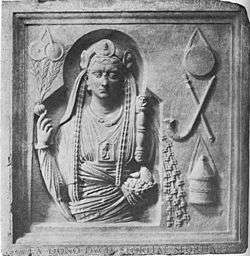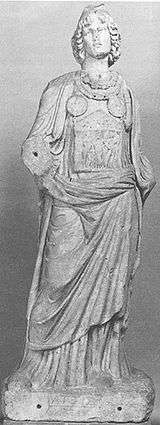Galli
A gallus (pl. galli) was a eunuch priest of the Phrygian goddess Cybele and her consort Attis, whose worship was incorporated into the state religious practices of ancient Rome.
History
The earliest references to the galli come from the Anthologia Palatina, a 10th century compilation of earlier material. These references do not explicitly mention emasculation. A fragment attributed to Callimachus cites the term gallai as denoting castration.[1]
Stephanus Byzantinus said that the name came from King Gallus.[2] Ovid (43 BC – 17 AD) says that the name is derived from the Gallus river in Phrygia.[3]
A connection has been made between the episode of the castration of Attis and the ritual mutilation of the galli.

At Pessinus, the centre of the Cybele cult, there were two high priests during the Hellenistic period, one with the title of "Attis" and the other with the name of "Battakes". Both were eunuchs.[4] The high priests had considerable political influence during this period, and letters exist from a high priest of Attis to the kings of Pergamon, Eumenes II and Attalus II, inscribed on stone. Later, during the Flavian period, there was a college of ten priests, not castrated, and now Roman citizens, but still using the title "Attis".[5]
The first galli arrived in Rome when the Senate officially adopted Cybele as a state goddess in 204 BC.[6] Roman citizens were prohibited from becoming galli, which meant that either the galli were Asian or they were slaves. Under Claudius, this ban was lifted.[7]
In Rome, the head of the galli was known as the archigallus, at least from the period of Claudius on. A number of archaeological finds depict the archigallus wearing luxurious and extravagant costumes. The archigallus was always a Roman citizen chosen by the quindecimviri sacris faciundis, whose term of service lasted for life.[8] Along with the institution of the archigallus came the Phrygianum sanctuary as well as the rite of the taurobolium as it pertains to the Magna Mater, two aspects of the Magna Mater’s cultus that the archigallus held dominion over.[9]
Eventually Domitian reaffirmed that Roman citizens were forbidden to practice eviratio (castration).[10]

The galli castrated themselves during an ecstatic celebration called the Dies sanguinis, or "Day of Blood", which took place on March 24.[11] At the same time they put on women's costume, mostly yellow in colour, and a sort of turban, together with pendants and ear-rings. They also wore their hair long, and bleached, and wore heavy makeup. They wandered around with followers, begging for charity, in return for which they were prepared to tell fortunes. On the day of mourning for Attis they ran around wildly and disheveled. They performed dances to the music of pipes and tambourines, and, in an ecstasy, flogged themselves until they bled.[10]
Being a Roman citizen, as well as being employed by the Roman State, meant that the archigallus had to preserve the traditions of Cybele's cult while not violating Roman prohibitions in religious behavior. Hence, some argue that the archigallus was never a eunuch, as all citizens of Rome were forbidden from emasculation.[12] However, under Claudius Roman citizens were permitted to be castrated up until the reign of Domitian. The signs of their office have been described as a type of crown, possibly a laurel wreath, as well as a golden bracelet known as the occabus.[9]
In the 4th century, some currents of extreme asceticism in Christianity advocated self-castration. This practice was attacked as a return to the religious excesses of the galli by Basil of Ancyra. John Chrysostom in 390 attacked self-castrating Christians of being Manichaean heretics. Augustine likewise phrased his opposition to self-castration as an attack on the galli. By extension, Luther would later use the same comparison in his attack on clerical celibacy.[13]
Because the galli castrated themselves and wore women's clothing, accessories and makeup, some modern scholars have interpreted them as transgender.[14][15]
Palatine Anthology
The following are quotations from the English translation of the Greek Anthology by W. R. Paton (1920).
To thee, my mother Rhea, nurse of Phrygian lions, whose devotees tread the heights of Dindymus, did womanish Alexis, ceasing from furious clashing of the brass, dedicate these stimulants of his madness— his shrill-toned cymbals, the noise of his deep-voiced flute, to which the crooked horn of a younger steer gave a curved form, his echoing tambourines, his knives reddened with blood, and the yellow hair which once tossed on his shoulders. Be kind, O Queen, and give rest in his old age from his former wildness to him who went mad in his youth.
Clytosthenes, his feet that raced in fury now enfeebled by age, dedicates to thee, Rhea of the lion-ear, his tambourines beaten by the hand, his shrill hollow-rimmed cymbals, his double-flute that calls through its horn, on which he once made shrieking music, twisting his neck about, and the two-edged knife with which he opened his veins.
Greek Anthology, Book VI, 94
The priest of Rhea, when taking shelter from the winter snow-storm he entered the lonely cave, had just wiped the snow off his hair, when following on his steps came a lion, devourer of cattle, into the hollow way. But he with outspread hand beat the great tambour he held and the whole cave rang with the sound. Nor did that woodland beast dare to support the holy boom of Cybele, but rushed straight up the forest-clad hill, in dread of the half-girlish servant of the goddess, who hath dedicated to her these robes and this his yellow hair.
Greek Anthology, Book VI, 217
A begging eunuch priest of Cybele was wandering through the upland forests of Ida, and there met him a huge lion, its hungry throat dreadfully gaping as though to devour him. Then in fear of the death that faced him in its raving jaws, he beat his tambour from the holy grove. The lion shut its murderous mouth, and as if itself full of divine frenzy, began to toss and whirl its mane about its neck. But he thus escaping a dreadful death dedicated to Rhea the beast that had taught itself her dance.
Greek Anthology, Book VI, 218
Goaded by the fury of the dreadful goddess, tossing his locks in wild frenzy, clothed in woman's raiment with well-plaited tresses and a dainty netted hair-caul, a eunuch once took shelter in a mountain cavern, driven by the numbing snow of Zeus. But behind him rushed in unshivering a lion, slayer of bulls, returning to his den in the evening, who looking on the man, snuffing in his shapely nostrils the smell of human flesh, stood still on his sturdy feet, but rolling his eyes roared loudly from his greedy jaws. The cave, his den, thunders around him and the wooded peak that mounts nigh to the clouds echoes loud. But the priest startled by the deep voice felt all his stirred spirit broken in his breast. Yet he uttered from his lips the piercing shriek they use, and tossed his whirling locks, and holding up his great tambour, the revolving instrument of Olympian Rhea, he beat it, and it was the saviour of his life; for the lion hearing the unaccustomed hollow boom of the bull's hide was afraid and took to flight. See how all-wise necessity taught a means of escape from death!
Greek Anthology, Book VI, 219
Chaste Atys, the gelded servant of Cybele, in frenzy giving his wild hair to the wind, wished to reach Sardis from Phrygian Pessinus; but when the dark of evening fell upon him in his course, the fierce fervour of his bitter ecstasy was cooled and he took shelter in a descending cavern, turning aside a little from the road. But a lion came swiftly on his track, a terror to brave men and to him an inexpressible woe. He stood speechless from fear and by some divine inspiration put his hand to his sounding tambour. At its deep roar the most courageous of beasts ran off quicker than a deer, unable to bear the deep note in its ears, and he cried out, "Great Mother, by the banks of the Sangarius I dedicate to thee, in thanks for my life, my holy thalame and this noisy instrument that caused the lion to fly."
Greek Anthology, Book VI, 220
The long-haired priest of Rhea, the newly gelded, the dancer from Lydian Tmolus whose shriek is heard afar, dedicates, now he rests from his frenzy, to the solemn Mother who dwells by the banks of Sangarius these tambourines, his scourge armed with bones, these noisy brazen cymbals, and a scented lock of his hair.
Greek Anthology, Book VI, 234
The priest of Rhea dedicated to the mountain-Mother of the gods this raiment and these locks owing to an adventure such as this. As he was walking alone in the wood a savage lion met him and a struggle for his life was imminent. But the goddess put it in his mind to beat his tambourine and he made the ravening brute take flight, dreading the awful din. For this reason his locks hang from the whistling branches.
Greek Anthology, Book VI, 237
See also
Notes
- Lancellotti, Maria Grazia (2002). Attis, between myth and history: king, priest, and God; Volume 149 of Religions in the Graeco-Roman world. BRILL. pp. 96–97. ISBN 978-90-04-12851-4.
- Maarten J. Vermaseren, Cybele and Attis: the myth and the cult, translated by A. M. H. Lemmers, London: Thames and Hudson, 1977, p.96: "But according to others their name was derived from King Gallus 495 who in a state of frenzy had emasculated himself..." and p.199, "495. Steph. Byz. s.v. γάλλος (= H. Hepding, Attis, 74)."
- Maarten J. Vermaseren, Cybele and Attis: the myth and the cult, translated by A. M. H. Lemmers, London: Thames and Hudson, 1977, p.85, referencing Ovid, Fasti IV.9
- A. D. Nock, Eunuchs in Ancient Religion, ARW, XXIII (1925), 25–33 = Essays on Religion and the Ancient World, I (Oxford, 1972), 7–15.
- Maarten J. Vermaseren, Cybele and Attis: the myth and the cult, translated by A. M. H. Lemmers, London: Thames and Hudson, 1977, p. 98.
- Luther H. Martin, Hellenistic Religions: An Introduction, Oxford University Press, 1987, ISBN 019504391X p. 83
- Maarten J. Vermaseren, Cybele and Attis: the myth and the cult, translated by A. M. H. Lemmers, London: Thames and Hudson, 1977, p.96: "Furthermore Cybele was to be served by only oriental priests; Roman citizens were not allowed to serve until the times of Claudius."
- Dictionary of Roman religion by Lesley Adkins, Roy A. Adkins, Oxford University Press, 1996 ISBN 0-19-514233-0 p. 91
- The cults of the Roman Empire, The Great Mother and her Eunuchs, by Robert Turcan, Wiley-Blackwell, 1996 ISBN 0-631-20047-9 p. 51
- Maarten J. Vermaseren, Cybele and Attis: the myth and the cult, translated by A. M. H. Lemmers, London: Thames and Hudson, 1977, p.97.
- Maarten J. Vermaseren, Cybele and Attis: the myth and the cult, translated by A. M. H. Lemmers, London: Thames and Hudson, 1977, p.115: "The Day of Blood (dies sanguinis) is the name given to the ceremonies on 24 March. On this day the priests flagellated themselves until the blood came 662 and with it they sprinkled the effigy and the altars in the temple."
- The cults of the Roman Empire, The Great Mother and her Eunuchs, by Robert Turcan, Wiley-Blackwell, 1996 ISBN 0-631-20047-9 p. 49
- Gary Taylor, Castration: An Abbreviated History of Western Manhood (2002), 68–78.
- Kirsten Cronn-Mills, Transgender Lives: Complex Stories, Complex Voices (2014, ISBN 0761390227), page 39
- Teresa Hornsby, Deryn Guest, Transgender, Intersex and Biblical Interpretation (2016, ISBN 0884141551), page 47
References
- John Bell (1790). Bell's New Pantheon; or Historical Dictionary of the Gods, Demi-gods, Heroes and Fabulous Personages of Antiquity. London: Printed by and for J. Bell at the British Library, Strand. pp. 26, 82, 90, 322–323.
Galli.
External links
| Wikimedia Commons has media related to Galli. |